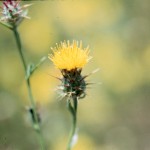Yellow Star-thistle, Yellow Starthistle
Centaurea solstitialis
Asteraceae (Sunflower Family)
Description
Centaurea solstitialis, Yellow Star-thistle, is a deep-rooted (i.e., taproot to over a meter), branching annual reaching up to one meter or more but usually around 25 inches or 60 cm tall. It appears as a rounded, bushy plant in the field. Yellow Star-thistle begins as a basal rosette of 6-28 lobed, petiole leaves reaching up to 15-20 cm. Then, it sends up a rigid winged stem with winged branches carrying thick, sharp-pointed leaves which are narrow, smooth-edged near the tip, and lobed at the base. The upper stem leaves are short, often only 2.5 cm. All the leaves are covered with woolly hairs. Inconspicuous, urn-shaped, and bright yellow flowers are borne at the ends of stems in the spring. They have flowerheads bearing 10 to 50 flowers with numerous, overlapping, stiff involucral bracts. Yellow spines reaching 2.5 cm emanate from the stiff middle bracts forming a star shape. Just after flowering, the plant dies. Two kinds of seeds are produced. Ninety percent have plumes that help with wind dispersal, and the others do not. Yellow Star-thistle can produce 100s to 1000s of seeds some of which remain viable in the seed bank for up to a decade. Its sister species, also an invasive, Malta Star-thistle (Centaurea melitensis) is distinguished by its covering of dense white hairs and its thistle-like seedpod armed with sharp barbs. It appears to be spreading across Texas. The USDA PLANTS database maps show Yellow Star-thistle in only a few counties while showing Malta Star-thistle throughout southwestern sections of the state. The long, stout spines on the flowerheads discourage any grazing though the plant is useful in providing nectar to honeybees.Habitat
Starthistles are introduced, invaders. Yellow Star-thistle is considered one of the most invasive weeds in the Intermountain West. Preferring deep loamy soils, a south-facing slope, and annual rainfall around 12-25”, it grows rapidly becoming an aggressive competitor with natives. Yellow Star-thistle covers millions of acres in California and is spreading in Texas. Its sister species, Malta Star-thistle, has already become disseminated through much of Texas. Starthistles grow in disturbed, otherwise bare areas such as roadsides, rangelands, railroad ROWs, and as weeds in cultivated fields.Toxic Agent
The starthistle toxin is thought to be sesquiterpene lactone. Toxicity occurs in horses after ingestion of 50 to 150 percent of the animal's weight in green plant material over a period of 1 to 3 months. Horses usually consume the young plant in early spring before stalk and spine growth. Yellow Star-thistle has been proven toxic to horses in experimental trials; Malta Star-thistle is implicated only in case reports.Signs of Livestock Ingestion
Signs of poisoning in horses are attributed to brain damage and may include: Drowsiness; Tongue flicking, lip twitching due to one-sided paralysis; Chewing movements; Difficulty eating and drinking; Aimless walking.Management Strategies
Maintaining good range condition, sound supplemental protein, and mineral feeding programs will help prevent poisoning. Even though Malta Star-thistle is widespread across Texas and the southwest, there are few poisoning cases. The greatest concern is probably the continuing spread of the more toxic Yellow Star-thistle as a future problem in Texas. In areas of extreme infestations, chemical control strategies may be warranted. Neither Yellow nor Malta Star-thistle is difficult to control with herbicides. Use general broadleaf weed compounds such as 2, 4-D or Grazon P+D®. Apply in the spring when there are 4 to 6 inches of growth and good growing conditions. Five species of insects have been used in the western US to control this weed. Prescribed fire has also been successful; however, it is usually not intense enough to destroy the seed bank. For small stands, hand removal including the root is effective.Images
Plant Characteristics
Flower Color: Yellow
Seed Type: Non-Encapsulated
Duration: Annual
Stem Texture: Prickly, Spiny, or Thorny
Growth Habit: Forbs/Broadleaf
Leaf Shape
 : Simple with Pinnate or Parallel Venation
: Simple with Pinnate or Parallel Venation
Season: Warm
Distribution
 : 01 - Pineywoods, 03 - Post Oak Savannah, 04 - Blackland Prairies, 05 - Cross Timbers and Prairies, 07 - Edwards Plateau
: 01 - Pineywoods, 03 - Post Oak Savannah, 04 - Blackland Prairies, 05 - Cross Timbers and Prairies, 07 - Edwards Plateau
Distributions
Distribution refers to the ecological region in Texas that a plant has been found. You can also view a clickable map.
Collection: Toxics
Livestock Affected: Horses
Livestock Signs: Continuous Walking, Pushing On Objects, Unable To Eat/Drink





